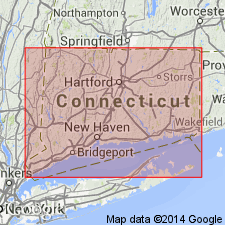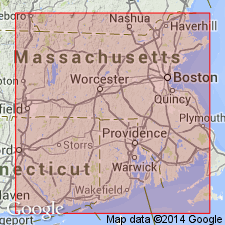
- Usage in publication:
-
- Mamacoke Formation
- Modifications:
-
- Revised
- AAPG geologic province:
-
- New England province
Summary:
The rocks below 815 m in the Moodus research hole, CT, are correlated with the Late Proterozoic Waterford Group of the Avalon terrane, which is here called Waterford Complex and divided into the Hadlyme and Mamacoke Formations. [This is first use of Hadlyme as a formal name. Previously mapped as Hadlyme belt by Lundgren (1963) and gneiss of Hadlyme by Wintsch (1985) and Wintsch and Alelinikoff (1987).] Sequence is dominated by biotite- and hornblende-bearing plagioclase gneisses, but also contains thin layers of granitic gneiss, amphibolite, and pegmatite.
Source: GNU records (USGS DDS-6; Reston GNULEX).

- Usage in publication:
-
- Mamacoke Formation
- Modifications:
-
- Overview
- Dominant lithology:
-
- Gneiss
- Amphibolite
- AAPG geologic province:
-
- New England province
Summary:
Usage of Waterford Group follows Goldsmith (1980; 1985). Described as a sequence of metavolcanic and metaplutonic plagioclase gneisses and amphibolites that unconformably overlies the Plainfield Formation in the Hope Valley terrane. (Hope Valley and Esmond-Dedham terranes compose the Avalon superterrane of this report.) Thickness of Waterford is variable; ranges to 3,100 m. Subdivided (ascending) into Mamacoke Formation with its upper Cohanzie Member (first used?), New London Gneiss, and Rope Ferry Gneiss. Upper member of Mamacoke consists of a light-colored, sugary-textured biotite-quartz-feldspar gneiss with quartz-sillimanite nodules and diopside and epidote gneiss and schist layers; dark gray biotite-plagioclase gneiss with abundant small red garnets and sillimanite; a coarse-grained amphibolite that occurs as blocks and lenses in a granitoid matrix; and locally thin, white quartzite layers at the top. Lower member described as gray biotite-quartz-plagioclase gneiss, with prominent magnetite on weathered surfaces and minor layers of amphibolite, hornblende-bearing gneiss, and thin quartzite beds. Age is Late Proterozoic.
Source: GNU records (USGS DDS-6; Reston GNULEX).
For more information, please contact Nancy Stamm, Geologic Names Committee Secretary.
Asterisk (*) indicates published by U.S. Geological Survey authors.
"No current usage" (†) implies that a name has been abandoned or has fallen into disuse. Former usage and, if known, replacement name given in parentheses ( ).
Slash (/) indicates name conflicts with nomenclatural guidelines (CSN, 1933; ACSN, 1961, 1970; NACSN, 1983, 2005, 2021). May be explained within brackets ([ ]).

